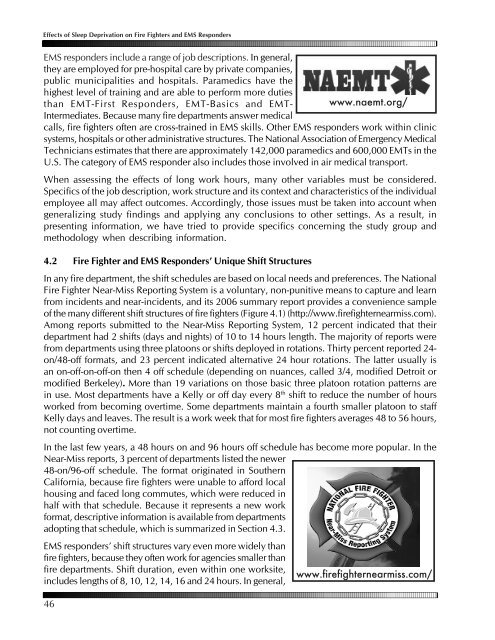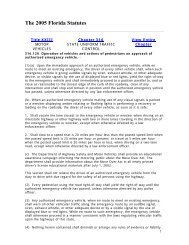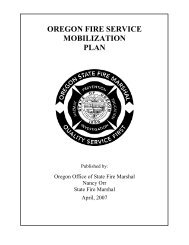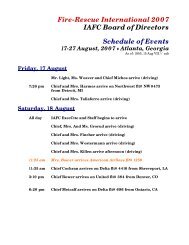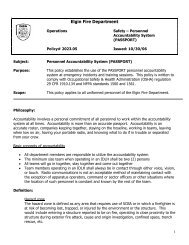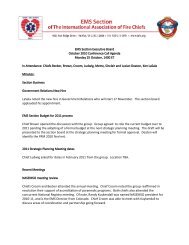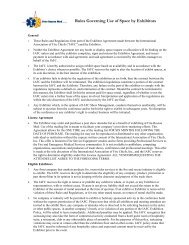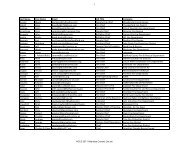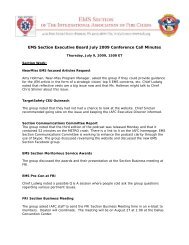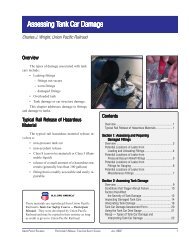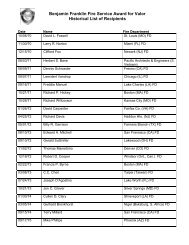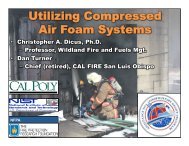Effects of Sleep Deprivation on Fire Fighters and EMS ... - NAEMT
Effects of Sleep Deprivation on Fire Fighters and EMS ... - NAEMT
Effects of Sleep Deprivation on Fire Fighters and EMS ... - NAEMT
Create successful ePaper yourself
Turn your PDF publications into a flip-book with our unique Google optimized e-Paper software.
<str<strong>on</strong>g>Effects</str<strong>on</strong>g> <str<strong>on</strong>g>of</str<strong>on</strong>g> <str<strong>on</strong>g>Sleep</str<strong>on</strong>g> <str<strong>on</strong>g>Deprivati<strong>on</strong></str<strong>on</strong>g> <strong>on</strong> <strong>Fire</strong> <strong>Fighters</strong> <strong>and</strong> <strong>EMS</strong> Resp<strong>on</strong>ders<br />
<strong>EMS</strong> resp<strong>on</strong>ders include a range <str<strong>on</strong>g>of</str<strong>on</strong>g> job descripti<strong>on</strong>s. In general,<br />
they are employed for pre-hospital care by private companies,<br />
public municipalities <strong>and</strong> hospitals. Paramedics have the<br />
highest level <str<strong>on</strong>g>of</str<strong>on</strong>g> training <strong>and</strong> are able to perform more duties<br />
than EMT-First Resp<strong>on</strong>ders, EMT-Basics <strong>and</strong> EMT- www.naemt.org/<br />
Intermediates. Because many fire departments answer medical<br />
calls, fire fighters <str<strong>on</strong>g>of</str<strong>on</strong>g>ten are cross-trained in <strong>EMS</strong> skills. Other <strong>EMS</strong> resp<strong>on</strong>ders work within clinic<br />
systems, hospitals or other administrative structures. The Nati<strong>on</strong>al Associati<strong>on</strong> <str<strong>on</strong>g>of</str<strong>on</strong>g> Emergency Medical<br />
Technicians estimates that there are approximately 142,000 paramedics <strong>and</strong> 600,000 EMTs in the<br />
U.S. The category <str<strong>on</strong>g>of</str<strong>on</strong>g> <strong>EMS</strong> resp<strong>on</strong>der also includes those involved in air medical transport.<br />
When assessing the effects <str<strong>on</strong>g>of</str<strong>on</strong>g> l<strong>on</strong>g work hours, many other variables must be c<strong>on</strong>sidered.<br />
Specifics <str<strong>on</strong>g>of</str<strong>on</strong>g> the job descripti<strong>on</strong>, work structure <strong>and</strong> its c<strong>on</strong>text <strong>and</strong> characteristics <str<strong>on</strong>g>of</str<strong>on</strong>g> the individual<br />
employee all may affect outcomes. Accordingly, those issues must be taken into account when<br />
generalizing study findings <strong>and</strong> applying any c<strong>on</strong>clusi<strong>on</strong>s to other settings. As a result, in<br />
presenting informati<strong>on</strong>, we have tried to provide specifics c<strong>on</strong>cerning the study group <strong>and</strong><br />
methodology when describing informati<strong>on</strong>.<br />
4.2 <strong>Fire</strong> Fighter <strong>and</strong> <strong>EMS</strong> Resp<strong>on</strong>ders’ Unique Shift Structures<br />
In any fire department, the shift schedules are based <strong>on</strong> local needs <strong>and</strong> preferences. The Nati<strong>on</strong>al<br />
<strong>Fire</strong> Fighter Near-Miss Reporting System is a voluntary, n<strong>on</strong>-punitive means to capture <strong>and</strong> learn<br />
from incidents <strong>and</strong> near-incidents, <strong>and</strong> its 2006 summary report provides a c<strong>on</strong>venience sample<br />
<str<strong>on</strong>g>of</str<strong>on</strong>g> the many different shift structures <str<strong>on</strong>g>of</str<strong>on</strong>g> fire fighters (Figure 4.1) (http://www.firefighternearmiss.com).<br />
Am<strong>on</strong>g reports submitted to the Near-Miss Reporting System, 12 percent indicated that their<br />
department had 2 shifts (days <strong>and</strong> nights) <str<strong>on</strong>g>of</str<strong>on</strong>g> 10 to 14 hours length. The majority <str<strong>on</strong>g>of</str<strong>on</strong>g> reports were<br />
from departments using three plato<strong>on</strong>s or shifts deployed in rotati<strong>on</strong>s. Thirty percent reported 24-<br />
<strong>on</strong>/48-<str<strong>on</strong>g>of</str<strong>on</strong>g>f formats, <strong>and</strong> 23 percent indicated alternative 24 hour rotati<strong>on</strong>s. The latter usually is<br />
an <strong>on</strong>-<str<strong>on</strong>g>of</str<strong>on</strong>g>f-<strong>on</strong>-<str<strong>on</strong>g>of</str<strong>on</strong>g>f-<strong>on</strong> then 4 <str<strong>on</strong>g>of</str<strong>on</strong>g>f schedule (depending <strong>on</strong> nuances, called 3/4, modified Detroit or<br />
modified Berkeley). More than 19 variati<strong>on</strong>s <strong>on</strong> those basic three plato<strong>on</strong> rotati<strong>on</strong> patterns are<br />
in use. Most departments have a Kelly or <str<strong>on</strong>g>of</str<strong>on</strong>g>f day every 8 th shift to reduce the number <str<strong>on</strong>g>of</str<strong>on</strong>g> hours<br />
worked from becoming overtime. Some departments maintain a fourth smaller plato<strong>on</strong> to staff<br />
Kelly days <strong>and</strong> leaves. The result is a work week that for most fire fighters averages 48 to 56 hours,<br />
not counting overtime.<br />
In the last few years, a 48 hours <strong>on</strong> <strong>and</strong> 96 hours <str<strong>on</strong>g>of</str<strong>on</strong>g>f schedule has become more popular. In the<br />
Near-Miss reports, 3 percent <str<strong>on</strong>g>of</str<strong>on</strong>g> departments listed the newer<br />
48-<strong>on</strong>/96-<str<strong>on</strong>g>of</str<strong>on</strong>g>f schedule. The format originated in Southern<br />
California, because fire fighters were unable to afford local<br />
housing <strong>and</strong> faced l<strong>on</strong>g commutes, which were reduced in<br />
half with that schedule. Because it represents a new work<br />
format, descriptive informati<strong>on</strong> is available from departments<br />
adopting that schedule, which is summarized in Secti<strong>on</strong> 4.3.<br />
<strong>EMS</strong> resp<strong>on</strong>ders’ shift structures vary even more widely than<br />
fire fighters, because they <str<strong>on</strong>g>of</str<strong>on</strong>g>ten work for agencies smaller than<br />
fire departments. Shift durati<strong>on</strong>, even within <strong>on</strong>e worksite,<br />
includes lengths <str<strong>on</strong>g>of</str<strong>on</strong>g> 8, 10, 12, 14, 16 <strong>and</strong> 24 hours. In general,<br />
46<br />
www.firefighternearmiss.com/


